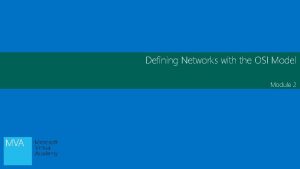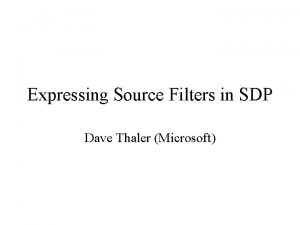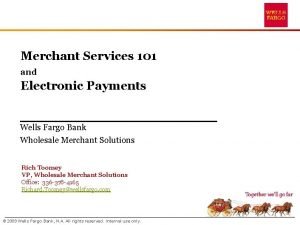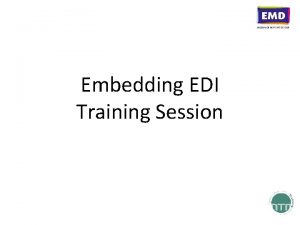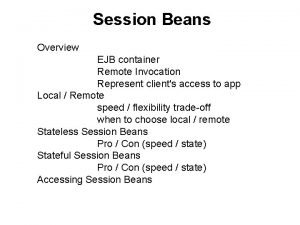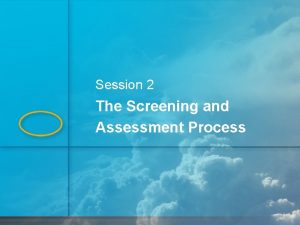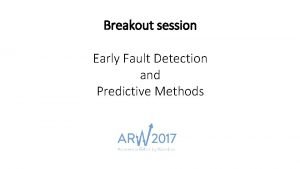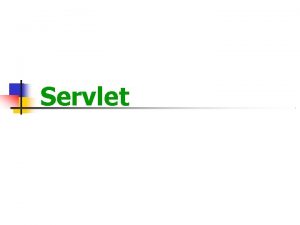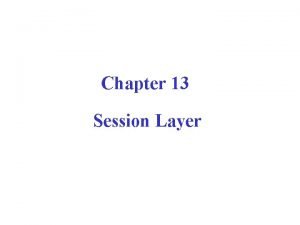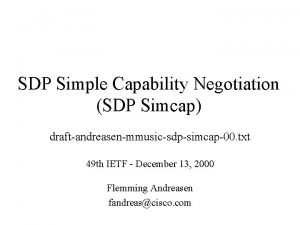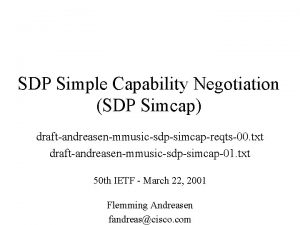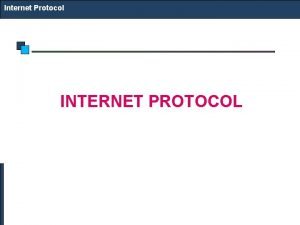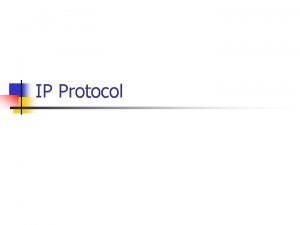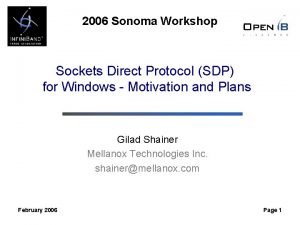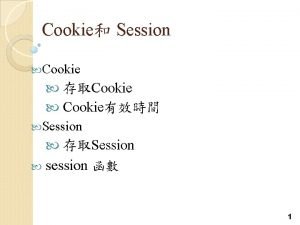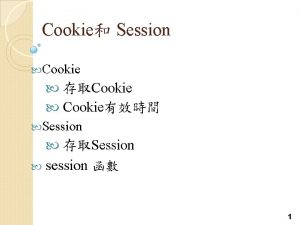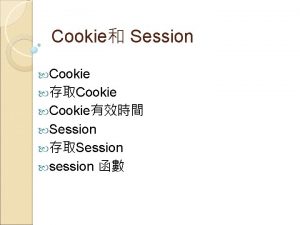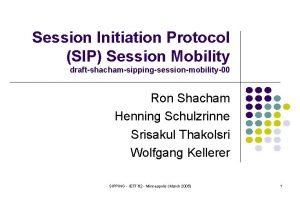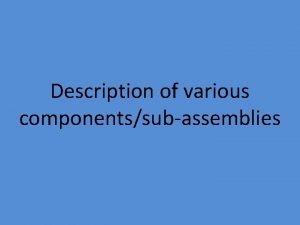SDP o Session Description Protocol SDP n an






















![o Syntax a=<attribute field> [" : "<attribute value>] n attribute field o contains the o Syntax a=<attribute field> [" : "<attribute value>] n attribute field o contains the](https://slidetodoc.com/presentation_image_h2/ae297f030659c1c6b224fb9ee47baf43/image-23.jpg)




![o Syntax of the rtpmap attribute a=rtpmap: <payload type> <encoding name>/<clock rate>[/<encoding parameters>] n o Syntax of the rtpmap attribute a=rtpmap: <payload type> <encoding name>/<clock rate>[/<encoding parameters>] n](https://slidetodoc.com/presentation_image_h2/ae297f030659c1c6b224fb9ee47baf43/image-28.jpg)

- Slides: 29

SDP

o Session Description Protocol (SDP) n an application-layer protocol intended to describe multimedia sessions n a text-based protocol n when describing a session the caller and callee indicate their respective "receive" capabilities, media formats and receive address/port

n capability exchange can be performed o during session set-up or o during the session itself (while the session is in progress)

9. 1 SDP message contents 9. 2 SDP message format 9. 3 Selected SDP lines

9. 1 SDP message contents o An SDP message contains three levels of information n Session-level description o includes the session identifier and other session level parameters, such as the IP address, subject, contact info about the session and/or creator n Timing description o start and stop times, repeat times, one or more media-level descriptions

n Media type and format o transport protocol and port number, other medialevel parameters o The three levels of information must appear in the order described above o The SDP message is a collection of SDP lines

9. 1. 1 Session description 9. 1. 2 Time description 9. 1. 3 Media description

9. 1. 1 Session description o Table 9. 1 lists all the session-level description lines and indicates their mandate and the letter used as the line name


9. 1. 2 Time description o Table 9. 2 lists all the time-level description lines and indicates their mandate and the letter used as the line name


9. 1. 3 Media description o Table 9. 3 lists all the media-level description lines and indicates their mandate and the letter used as the line name


9. 2 SDP message format o The SDP syntax is very strict and all lines follow the same format o Every SDP line has the format <character>=<value> value=parameter 1 parameter 2. . . parameter. N o Each SDP line ends with a carriage return line feed (CRLF) and each line has a defined number of parameters

9. 3 Selected SDP lines 9. 3. 1 Protocol version line 9. 3. 2 Connection information line 9. 3. 3 Media line 9. 3. 4 Attribute line 9. 3. 5 The rtpmap attribute

9. 3. 1 Protocol version line o The SDP protocol version is 0 and, therefore, the v-line in an SDP message must always be set to 0 v=0

9. 3. 2 Connection information line o The c-line must be either present at the session level or media level o It must be present at the media level if it is not present at the session level o If it is present at both levels, then media-level connection information overrides session-level information c=<network type> <address type> <network address>

o The c-line has three parameters n network type o the only currently defined network type is the Internet o the value appears as "IN" n address type o there are two address types, IP 4 or IP 6 n network address o this parameter identifies the IP address or domain name where media are received

9. 3. 3 Media line o The m-line carries information about the media, including transport information o The syntax is as follows m=<media> <port> <transport> <format-list> o The m-line has four parameters n Media o the type of media (e. g. , audio, video, game) n Port o contains the port number where these media can be received

n Transport o the transport protocol to use, either the User Datagram Protocol (UDP) or Real-time Transport Protocol Audio and Video Profile (RTP/AVP) n Format-list o contains more information about the media, usually payload types defined in RTP/AVPs

o If the transport is RTP/AVP, then the port number for the RTP Control Protocol (RTCP) = RTP port + 1 o RTCP is assumed to be sent whenever RTP is carrying the media o The RTP port number must always be an even number and, therefore, the RTCP port is an odd number

9. 3. 4 Attribute line o The a-line defines the attributes of the media o Attributes can be session-level attributes, media-level attributes or both o Attribute interpretation depends on the media tool being invoked
![o Syntax aattribute field attribute value n attribute field o contains the o Syntax a=<attribute field> [" : "<attribute value>] n attribute field o contains the](https://slidetodoc.com/presentation_image_h2/ae297f030659c1c6b224fb9ee47baf43/image-23.jpg)
o Syntax a=<attribute field> [" : "<attribute value>] n attribute field o contains the name of the attribute. n attribute value o optional, if present is separated from the attribute field by a colon o Table 9. 4 shows a list of the most commonly used attributes



9. 3. 5 The rtpmap attribute o For RTP-transported media, SDP can be used to bind a media-encoding codec to the media's RTP payload type n this is done using a payload-type number o Payload types n static payload types o the payload-type number is sufficient for the binding o the payload-type number is carried in the formatlist parameter of the media line

n dynamic payload types o the payload-type number is not sufficient and additional encoding information is needed o this is achieved using the rtpmap attribute
![o Syntax of the rtpmap attribute artpmap payload type encoding nameclock rateencoding parameters n o Syntax of the rtpmap attribute a=rtpmap: <payload type> <encoding name>/<clock rate>[/<encoding parameters>] n](https://slidetodoc.com/presentation_image_h2/ae297f030659c1c6b224fb9ee47baf43/image-28.jpg)
o Syntax of the rtpmap attribute a=rtpmap: <payload type> <encoding name>/<clock rate>[/<encoding parameters>] n payload type o carries the payload-type number as indicated in the m-line n encoding name o the codec name

n clock rate o bits per second n encoding parameters o media-specific parameters, including the number of channels, but not codec-specific parameters
 Session protocol data unit
Session protocol data unit Fabien bidet
Fabien bidet Msrp protocol
Msrp protocol Http protocol description
Http protocol description Sdp marketing
Sdp marketing Sdp support
Sdp support Rdp sdp difference
Rdp sdp difference Dave thaler
Dave thaler Sdp project ideas
Sdp project ideas Wells fargo gateway
Wells fargo gateway Telco sdp
Telco sdp Edi
Edi Training session design
Training session design Define social change
Define social change Stateful session bean life cycle
Stateful session bean life cycle Session 1 research simulation task
Session 1 research simulation task Hkn review session
Hkn review session Css session
Css session Session will start soon
Session will start soon Screening session
Screening session Instagram session cookie
Instagram session cookie Define breakout session
Define breakout session Servletcontext and servletconfig
Servletcontext and servletconfig Space cube session
Space cube session Session layer function
Session layer function Perbedaan session dan cookies
Perbedaan session dan cookies Meet the parents session
Meet the parents session Session 0 windows
Session 0 windows Welcome session agenda
Welcome session agenda Breakout session questions
Breakout session questions
